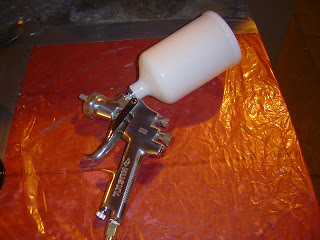Over the course of the past week, we have begun to prepare for the big dance, fiberglassing!!
Plug (the hull mold) construction is finally complete after some wet sanding, making it as smooth as a baby's bottom.
As much as all of us here wish we could just lay down some fiberglass, slop on some epoxy, and go home for the night, we cannot. Fiberglassing involves several steps to ensure a top-notch product. Most of the prep work has been, or is being done so we can begin tomorrow evening. Today, the hull group and others cut and organized various materials needed to fiberglass. There are four layers of material in the fiberglassing process. First, the fiberglass cloth is covered in a slow-curing epoxy and laid smoothly across the hull. Over the fiberglass is a plastic perforated sheet, which allows excess epoxy to seep through. On top of the perforated plastic sheet is a felt like material called breather. The breather absorbs some of the excess epoxy and is covered by the fourth layer, the vacuum bag. Inside the vacuum bag are custom build tubing and hoses that connect to an air pump. The pump sucks air from the vacuum bag creating a higher than atmospheric pressure on the fiberglass.
The whole process is labor intensive, especially for a mold of our size. To practice, we made a few model hull shapes and fiberglassed them. You can see the models below. We also have gone through and done a dry run. It's very similar to doing a show actually. We have the "set" completed, but now are just making sure our queues and dance steps are perfect.
If all goes well, you shall see some pictures of a fiberglassed mold by the weekend's end!
And now, the crowd favorite, the pictures!

The material on top of the table is the fiberglass and the blue (at least that's what my colorblind eyes see) material below is the perforated plastic sheet

A custom built stand for the roll of fiberglass

The finished hull mold covered in the green (again the eyes may be lying...) plastic vacuum bagging material. All of the layered sheets had to be specially cut to best fit the shape of the hull.

The air pump we will be using for fiberglassing courtesy of Carnegie Mellon SAE Racing team.

A finished practice model. This was made with four layers of fiberglass. It will be auctioned off as a collector's item in the near future.

Two foam models created to practice the proper fiberglassing technique

Mike (left) smiles for the camera as Nat (center) looks over the model boat

Llui (left) and Mike (right) discuss a fiberglass and wood sample to be used on the transom (rear/stearn) of the boat.

Lluis demonstrating the process of removing foam and bondo from hardened fiberglass. We are trying to preserve the mold for future years, but the verdict is still out on if it will be 100% possible.

Josh (left) and Brian (right) look over designs for the steering mechinism.
-Andrew



















































